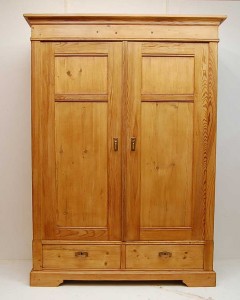How often have your heard about someone who made a fantastic find at their neighborhood garage sale, but were afraid of the cost and hard work involved, getting their discovery repaired and made new? Let’s discuss Antique Restoration Made Easy in this, part one of a two part series.

Antique Pine Armoire
1) Stripping the finish.
2) How to make repairs.
Typically, most period and antique furniture will have been refinished at some point in its history. This will create some interesting challenges when you remove the finish.
Depending on the age of the piece, it may have been originally finished in one of many different types of paint, or top coatings.
For example: Between 1700-1820’s most furnishings were hand made by local artisans. The finishing was left to the town finisher, or “Guilder”. Often the finish of choice for common furniture was ‘Milk’ based paint. For more expensive furnishings, locally made varnish was used as both sealer, and top coat.
From the early 1800’s to the early 1900’s more and more furnishings were factory produced. These furnishing would have been coated with Shellac (which is alcohol based), and/or top coated with ‘True’ or ‘Organic’ Varnish (turpentine, oil, rosin based).
Furnishings manufactured in the early to mid 1900’s were likely finished with Polyurethane, which is a chemical, polymer based Varnish. More recent furnishings may have been refinished with extremely durable, water based coatings and lacquers.
Because of the multiple layers of differing finish materials, and the age of the furnishing, not all finishes strip off easily with ordinary paint remover, so here are some alternatives to consider:
Milk Paint is probably the most difficult finish to remove with paint strippers. Made originally with organic solids for pigment, and thinned with milk, this finish dries to a rock hard finish, which will not yield to today’s chemical paint removers. The truth is, if you have acquired a furnishing with its original milk paint finish, it’s maintains a greater dollar value if you leave it alone. However, if you must refinish it, hand scraping, and sanding will effectively remove the paint.
Shellac finishes are recognizable by their deep red/rutty color. Shellac was, and still is commonly used as a wood sealer, prior to a top coat of varnish. Varnish can be removed with common paint remover, or lacquer thinner. Whereas Shellac will become a gummy, gooey mess! Shellac is better removed with isopropyl alcohol. Alcohol can dry very quickly, so this will require you to work in a cool shaded area, with good air circulation. Alcohol is also extremely flammable, so any rags utilized in the stripping process should be submerged in water, before disposal.
Most organic (rosin) based varnishes will melt away with common paint remover. But a stubborn finish can always be scraped, or sanded away. Old varnish becomes very brittle, and will scuff right away with a sharp scraping tool, or sander.
Polyurethanes, will respond well to paint removers (and very little else). Often a Polyurethane finish will require the use of a heat gun. Heat guns are available at you local paint and hardware center. They are not expensive, and are very much like your household hair dryer, but much, much hotter! Heat guns will cause the finish to blister, and peel away rapidly. Use extreme caution when employing a heat gun. Follow the manufacturer’s instructions, and avoid burning the furniture, or yourself!
Regardless of the method of removing the old finish; weather it is by hand scraping and sanding, using a heat gun, or chemically stripping, remember to always were protective coverings (gloves, long sleeves, goggles). Be sure to work in a well ventilated area, and properly dispose of any materials (removed finish) rags and tools in accordance with your local sanitation and building code requirements.
There are many environmentally safe, and Eco friendly, chemical based paint removers available today. Be sure to ask at your local paint and hardware center.



 Auto insurance quote
Auto insurance quote Get a Business Loan
Get a Business Loan